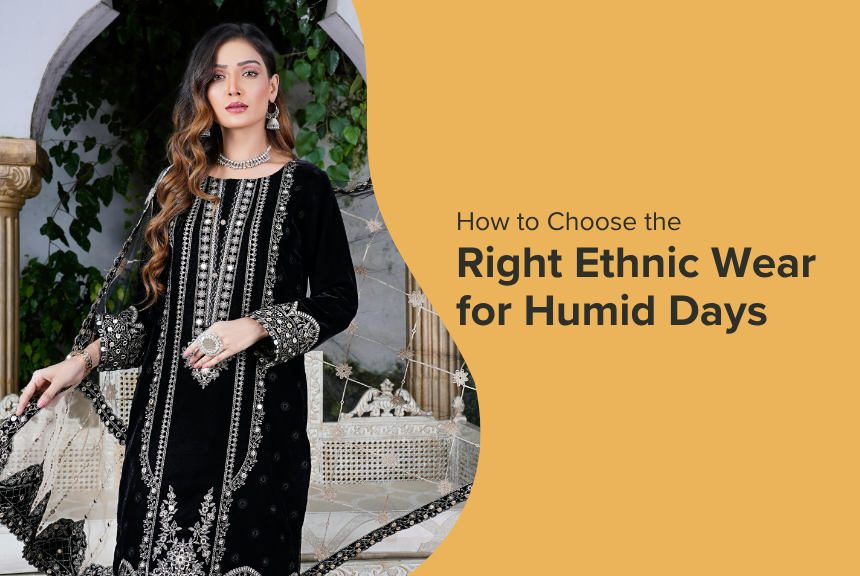How to Choose the Right Ethnic Wear for Humid Days
- by Vaya the Weaver

Summer and monsoon seasons bring their own unique challenges when it comes to styling ethnic wear. The combination of high temperatures, humidity, and unexpected downpours can make traditional clothing feel uncomfortable and difficult to maintain. However, with the right fabric choices, styling techniques, and care practices, you can stay elegantly dressed in your favorite ethnic outfits while remaining cool and comfortable throughout humid days.
Best Fabric Choices for Humid Weather
Cotton:
Cotton remains the gold standard for humid weather ethnic wear. This natural fiber is breathable, soft, and perfect for Indian weather conditions. Cotton absorbs moisture from your body, helping to cut moisture buildup between your clothes and skin. Different varieties offer varying benefits:
-
Mulmul (Muslin): Ultra-soft and breathable, perfect for hot climates
-
Khadi: Handwoven cotton known for its unique texture and excellent breathability
-
Cotton blends: Combine cotton's comfort with added durability and quick-drying properties
Linen:
Linen is highly absorbent, moisture-wicking, and soft, making it one of the best choices for hot and humid climates. This fabric absorbs sweat and evaporates it quickly, ensuring you stay fresh all day. Linen ethnic wear offers superior breathability with its open weave structure and naturally cooling properties. The fabric becomes softer with each wash, making it a long-term investment for your summer wardrobe.
Rayon and Modal:
Rayon is semi-synthetic with a light and air-permeable drape that feels cool and refreshing. Modal takes breathability a step further by offering superior moisture-wicking properties compared to cotton, pulling sweat away from your skin more effectively. These fabrics combine the comfort of natural fibers with enhanced performance characteristics.
Georgette and Chiffon:
While slightly heavier than chiffon, georgette still allows good airflow and keeps you comfortable in humid weather. Chiffon dupattas can be worn in hot weather and are suitable for both casual and formal occasions. These fabrics offer breathability while maintaining an elegant drape for special occasions.
Smart Styling Strategies for Humid Days
Choose Airy Silhouettes
When humidity rises, your attire should literally let you breathe. Opt for relaxed shapes instead of tight-fitting styles:
-
Flared kurtas and A-line dresses allow better air circulation
-
Straight-cut tunics prevent fabric from clinging to your body
-
Wide-leg bottoms and palazzos offer superior ventilation
-
Avoid super snug churidars in favor of airy, breathable alternatives
Color Psychology for Hot Weather
Light colors reflect heat and help maintain a fresher appearance throughout the day. Use lighter pastel or earthy colors such as mint green, powder blue, peach, or beige. These colors not only keep you cooler but also hide minor stains and sweat marks better than darker alternatives. Darker colors absorb heat, making them less suitable for hot, humid conditions.
Dupatta Alternatives and Modifications
Traditional heavy dupattas can become cumbersome in humid weather. Consider these alternatives:
-
Lightweight cotton stoles or printed scarves instead of heavy dupattas
-
Organza or mulmul dupattas for a breathable option
-
Skip the dupatta altogether and style your kurta as a standalone piece
-
Pre-stitched dupattas for convenience and reduced bulk
Monsoon-Specific Styling Tips
Hemline Considerations
Avoid floor-length lehengas or anarkalis that can trail in puddles. Instead, opt for:
-
Mid-calf kurtas and high-low tunics
-
Ankle-length bottoms that won't get soaked
-
Short kurtas paired with fitted bottoms for easy movement
Fabric Selection for Rainy Days
Choose quick-drying fabrics like cotton blends, Chanderi silk, or soft organza that dry quicker and hold their shape. Avoid heavy fabrics like velvet and brocade during monsoon season, as they take longer to dry and can become uncomfortable when wet.
Color Choices for Monsoon
Match the monsoon season vibe with bold colors like cobalt blue, fuchsia, bottle green, and deep reds. These darker shades and bold colors are practical and stylish for rainy days, as they mask splashes and stains better than pastels.
Essential Care and Maintenance
Immediate After-Wear Care
Proper care begins the moment you remove your ethnic wear:
-
Air out garments for 1-2 hours before storing to prevent moisture buildup
-
Address stains immediately using gentle dabbing rather than rubbing
-
Use fabric freshener spray for light refreshment between wears
Washing and Drying Techniques
For cotton ethnic wear, follow these guidelines:
-
Hand wash in cold water with mild detergent to maintain color and fabric quality
-
Avoid using harsh chemicals or bleach that can damage the fabric
-
Air dry in shaded areas away from direct sunlight to prevent fading
-
Iron while slightly damp for best results, or use a steamer instead of traditional ironing
Storage Solutions for Humid Weather
Proper storage is crucial during humid months:
-
Use breathable garment bags made of muslin or cotton instead of plastic covers
-
Add silica gel packets or moisture-absorbing sachets in your wardrobe
-
Store delicate pieces with acid-free tissue paper between folds
-
Ensure storage areas are clean, dry, and well-ventilated
Accessorizing for Humid Weather
Jewelry Considerations
Heavy jewelry can add to your discomfort in humid weather. Opt for:
-
Oxidized or resin pieces that don't corrode in humidity
-
Wooden or thread jewelry that's lightweight and humidity-resistant
-
Avoid direct contact between heavy jewelry and delicate fabrics
Footwear Selection
Choose practical yet stylish footwear:
-
Waterproof mules or Kolhapuris with rubber soles for monsoon days
-
Breathable flats or canvas sneakers for everyday wear
-
Avoid leather shoes during heavy monsoon periods
Hair and Makeup Adaptations
Humidity affects more than just your clothes:
-
Opt for easy-to-maintain hairstyles like braids, buns, or ponytails
-
Use anti-frizz serums to keep hair manageable
-
Choose waterproof makeup or go minimal to prevent smudging
Regional Adaptations
Coastal Areas
High salt air and humidity require additional considerations:
-
Use salt-resistant storage materials
-
Implement extra moisture control measures
-
Regular cleaning to remove salt deposits from fabrics
Urban Environments
Pollution concerns necessitate enhanced protection:
-
Air purification in storage areas
-
Enhanced sealing systems for stored garments
-
More frequent cleaning cycles
Seasonal Transition Tips
Pre-Monsoon Preparations
Before the rainy season begins:
-
Clean all ethnic wear before storage
-
Treat fabrics with anti-microbial sprays to prevent mold and mildew
-
Organize storage areas with proper ventilation
Post-Monsoon Care
After the humid season:
-
Air out all stored garments thoroughly
-
Check for any signs of moisture damage or mildew
-
Professional cleaning for heavily embellished pieces
Sustainable and Eco-Friendly Options
Consider eco-conscious fabric choices that are also humidity-friendly:
-
Organic cotton requires fewer chemicals and is gentler on skin
-
Bamboo fabrics offer natural moisture-wicking and hypoallergenic properties
-
Hemp requires minimal water and pesticides, making it environmentally sustainable
Quick Reference Guide
Do's for Humid Weather:
-
Choose breathable, natural fabrics
-
Wear lighter colors that reflect heat
-
Opt for loose, airy silhouettes
-
Use minimal, lightweight accessories
-
Store clothes with moisture absorbers
Don'ts for Humid Weather:
-
Avoid synthetic fabrics that trap heat
-
Skip heavy embellishments and multiple layers
-
Don't store clothes in plastic bags
-
Avoid tight-fitting garments
-
Don't ignore immediate stain treatment
Conclusion
Dressing in ethnic wear during humid days doesn't have to be a compromise between comfort and style. By choosing the right fabrics, employing smart styling techniques, and following proper care practices, you can maintain your elegant ethnic wardrobe throughout the most challenging weather conditions. Remember that the key lies in working with natural, breathable materials, embracing lighter silhouettes, and adapting your accessories to the climate. With these strategies, you can step out confidently in your favorite ethnic outfits, knowing you'll stay fresh, comfortable, and beautifully dressed regardless of the humidity outside.
The art of humid-weather ethnic dressing is ultimately about understanding your fabrics, respecting the climate, and making thoughtful choices that honor both tradition and comfort. By implementing these guidelines, you'll discover that ethnic wear can be your ally in any weather, allowing you to celebrate cultural fashion while staying perfectly comfortable.






